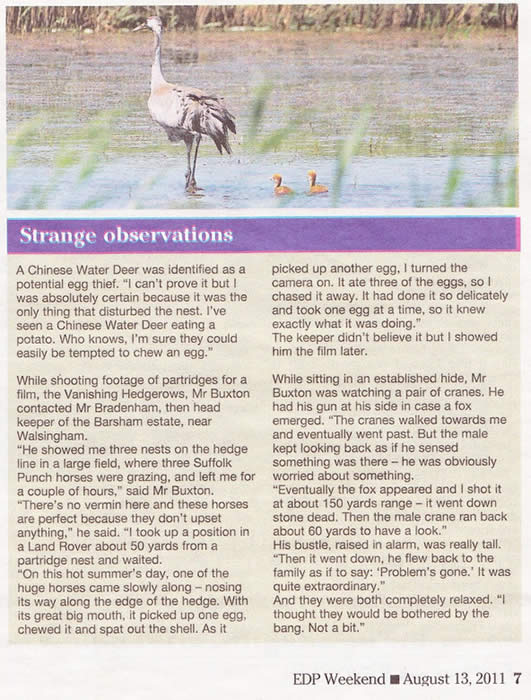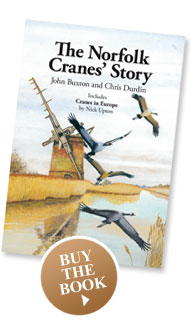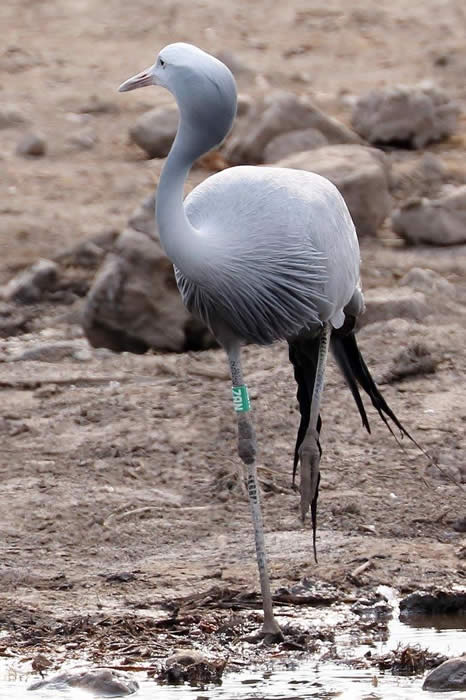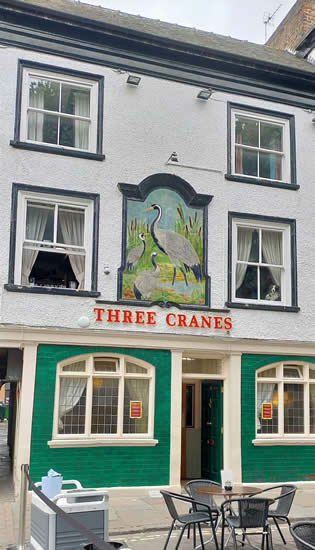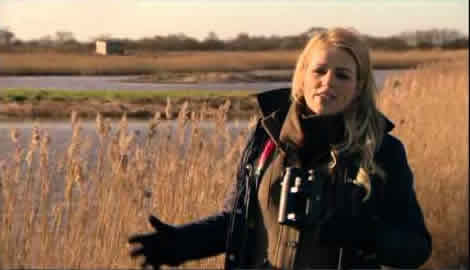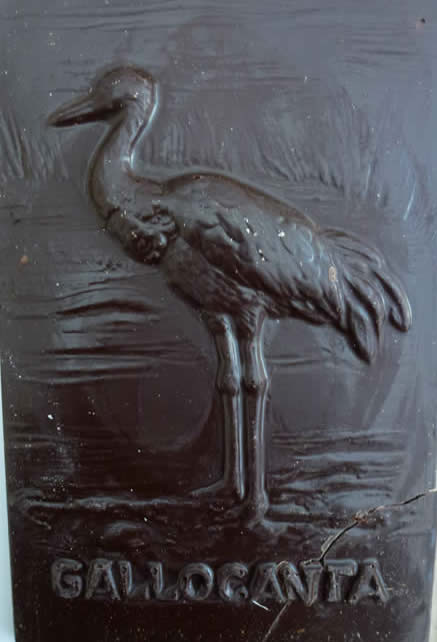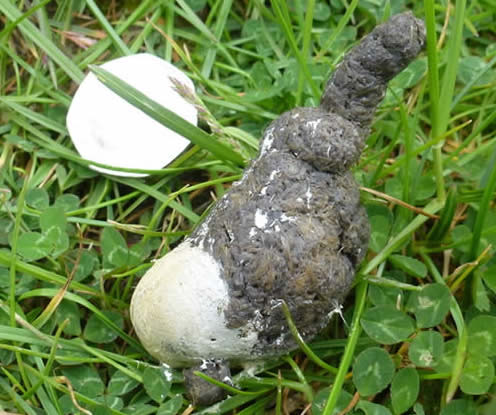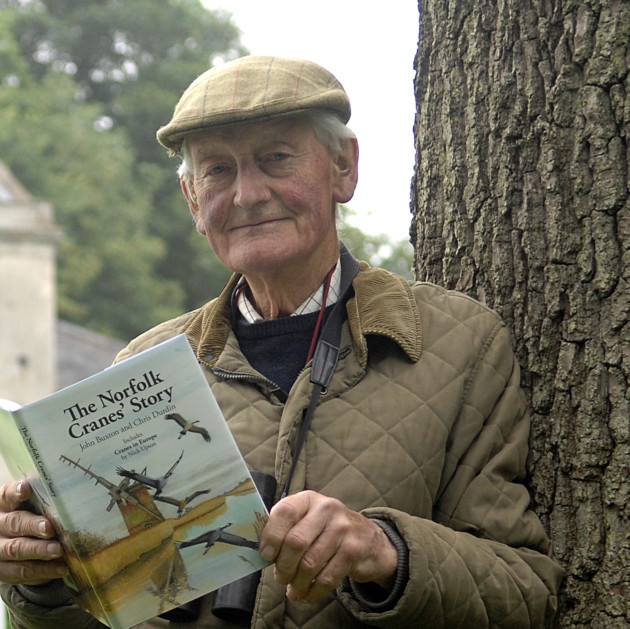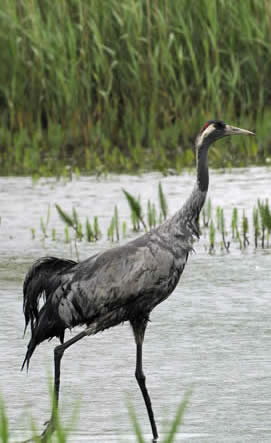News
How many cranes in Norfolk (2024)?
The Norfolk Bird & Mammal Report 2024 summarises the 'scarce but slowly increasing resident, mainly in the Broads and Fens' as follows. Breeding season: 16 pairs (14 confirmed, 1 possible, 1 non-breeding), 11 of which fledged young. Maximum counts at Hickling 83, November 2024, and Welney 55, January 2024. Records from the Brecks include successful breeding (birds more likely to have come from the Fens than the Broads).
Crane moult, a puzzle
Cranes are thought to moult in late May or early June every two years (though sometimes up to every three or four years) and are temporarily flightless. A short paper in British Birds, April 2025 "Atypical moult in an adult Common Crane Grus grus" by Adam Rowlands, Dave Fairhurst and Mike Marsh, describes an unusual moult on a crane breeding in coastal Suffolk. Essentially this bird had a mix of old and new flight feathers for at least three years. The authors speculate that a complete moult of flight feathers is less important for a resident population (as now occurs in East Anglia), "alongside nesting environments that have a greater presence of potential predators."
The Fens, 2024
Summary of cranes in the Fens for 2024 is 23 pairs at 11 sites (in four counties) reared 17 young. This means the Fens pairs have reared 107 young since their first breeding year of 2007 at RSPB Lakenheath Fen. The wintering flock in the Fens totalled 120 - 130 in mid-November 2024. Source: Norman Sills.
In the Broads, cranes bred again at Strumpshaw Fen, fledging one young, the first to fledge in Norfolk's Yare Valley.
Cranes on mosses in Scotland
A paper on lowland raised bogs in Scotland (by Ian Francis, Amanda Biggins, Hywel Maggs and Alan Marsden in British Birds, April 2025) shows declines in many breeding birds e.g. curlew, grouse species. Cranes, however, are a notable exception. "Since 2012, they have been breeding on small ponds in peat bogs and feeding on surrounding farmland. Derived from burgeoning numbers in continental Europe, around six pairs were scattered across moss sites in 2023, thee of which bred successfully, as well as other, non-breeding birds in the moss zone."
Somerset and Scottish cranes make a pair
A crane pair in Aberdeenshire is made up of a Scottish male and a female fledged from the reintroduction project in Somerset. This is the first time a crane released in England has been spotted with a mate in Scotland, and it probably hasn't happened in England either. Source: BBC News
2023 a record year for cranes - now 80 pairs.
Survey results show 2023 was another successful year for the common crane, with a record 80 pairs confirmed in the UK and 36 young known to have fledged. Source: news release from UK Crane Working Group, e.g. here on NWT's website.
Bird flu kills thousands of cranes in Hungary
"Bird flu has ripped through Hungary’s important population of migratory Common Cranes this autumn, killing tens of thousands of birds."
"Based on field studies, the number of dead cranes in Hungary is estimated at between 10,000 and 20,000 individuals " in the famous Hortobágy National Park. Source: BirdGuides. December 2023
Book special offer via NHBS
On NHBS, The Norfolk Cranes' Story is on special offer. We can also match this price for direct sales.
Cranes breeding at RSPB Strumpshaw Fen; four pairs in Lincolnshire; three pairs in Scotland [2023]
Cranes produced a chick at RSPB Strumpshaw Fen, the first time in the Yare Valley in the Broads - cranes in the Broads to date have bred in the Thurne, Ant and Bure valleys. Source: RSPB's Strumpshaw Fen's Facebook where there are movies of parents + single chick on 5 June.
Later reports showed it was indeed too soon to say 'bred successfully': the chick is thought to have been taken by a predator before it was able to fly.
2024: cranes bred again at Strumpshaw Fen, fledging one young, the first to fledge in Norfolk's Yare Valley.
Also Lincolnshire Wildife Trust reports at least four pairs of cranes in Lincolnshire this year, including three pairs at LWT's Willow Tree Fen nature reserve near Spalding. Source: Birdguides June 2023
There were three confirmed breeding pairs in Scotland in 2023, with four fledged again this year (Amanda Biggins, in litt.)
71 pairs of cranes in the UK
The crane "continues its comeback in the UK, with the latest breeding survey revealing there were 71 pairs across the UK in 2022.
"Of these 71 pairs, up to 64 pairs bred and fledged an impressive 39 chicks, significantly adding to the UK population. Cranes are slowly spreading across the UK and 2022 witnessed the first successful breeding along the Suffolk coast. The total UK population is now believed to be in excess of 200 birds." Source: BirdGuides.
A crane with a rubber ring on its beak
An account and photos from 1979 have just come to light, of a crane with a rubber ring around its beak. This was before cranes started to nest successfully at Horsey. This adds to the account in the book for 1979-1980. Full story in this blog.
Crane with rubber ring,
and after the ring's removal still showing a mark (Patrick Lee).
Two cranes fledged on Suffolk coast
"Cranes successfully raised two chicks on RSPB Snape Wetlands Nature Reserve earlier this year. They are the first-ever recorded pair to fledge young on the county's coast." Source: East Anglian Daily Times and BBC Suffolk.
Cranes nest in Ireland for a second year
According to BirdGuides, the cranes are on land owned by former peat producer Bord na Móna. July 2022
'UK crane population breaks further records in 2021'
"The latest breeding survey revealed a record-breaking 72 pairs across the UK in 2021.
Of these 72 pairs, up to 65 pairs bred and these fledged an impressive 40 chicks, significantly swelling the size of the UK population. The highest number of young fledged previously was 26 in 2019." Source BirdGuides, February 2022.
The 'Rare breeding birds in the UK in 2021' report (British Birds, Nov 2023) summarises the figures as 55-76 pairs at 47 sites.
"Norfolk plays major role in comeback of the previously extinct cranes"
Local version of above story in Eastern Daily Press, February 2022.
258,358 cranes in Spain
A Spanish crane census has been completed in Spain in recent weeks, with a total of 258,358 individuals counted. "Extremadura held the most, with 136,322 counted across the region. Aragón and Castilla la Mancha also held large numbers." Source, and more information, BirdGuides. January 2022
64 Cranes at Hickling
The December e-newsletter from Norfolk Wildlife Trust reports 64 cranes coming into roost at NWT Hickling Broad (November 2021, undated). They were seen from the raptor roost at Stubb Mill.
Drew Lyness describes the spectacle: "One large group of 30 cranes dropping into the roost at dusk was impressive enough, but when a second vocal flock of equal size arrived in at point-blank range over the viewpoint, that really was a 'punch the air' moment of excitement. All of this happened to the surrounding sound of thousands of pink-footed geese moving overhead."
Chris Durdin, co-author of The Norfolk Cranes' Story, was there in early November. A November afternoon at Hickling, 8 November is a guest blog about that occasion by Geoff Morries, on the Honeyguide blog.
A crane ringed in Finland is being seen in the group. Pictures and info on Norfolk Wildlife Facebook group, see also story below.
Somerset success, 2021
"The 2021 breeding season resulted in 15 fledged juveniles joining our Somerset flock." Source: The Great Crane Project.
Cranes breed in Oxfordshire in 2021
A single chick fledged at the RSPB's Otmoor nature reserve this year. Source: RSPB video on YouTube and BirdGuides. The coloured ring on the picture towards the end of the RSPB video shows that the bird pictured comes from the reintroduced population of the Great Crane Project, rather than the natural recolonisation in East Anglia.
Cranes in Scotland The occurrence and recolonisation of Common Cranes in Scotland by Amanda Biggins and Hywel Maggs is a splendid paper in the July 2021 British Birds. Like Norfolk and the Fens, cranes in Scotland are a natural recolonisation, which this paper charts. It covers the years 2012 to 2020. |
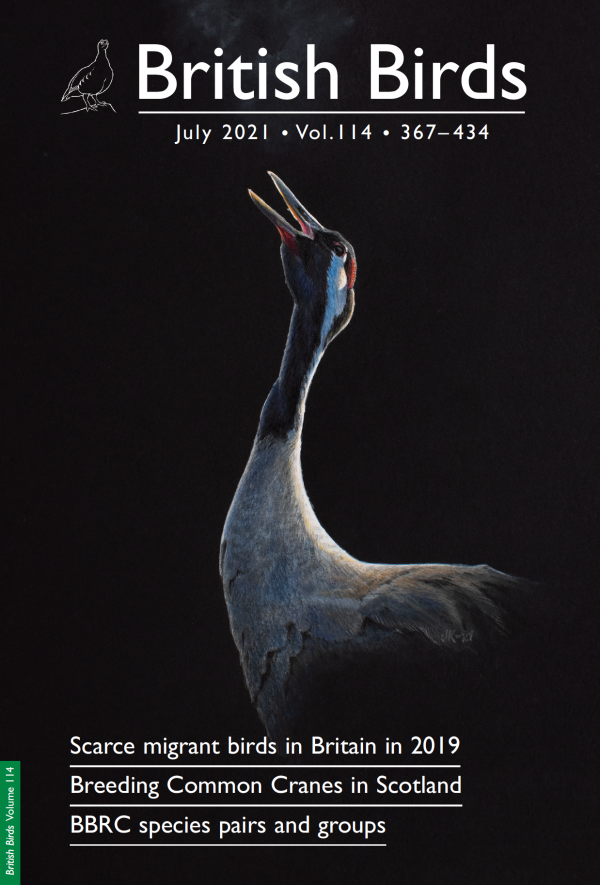 |
Crane from Finland in Norfolk
A crane with coloured 'tags' on its legs was seen at Ludham, Norfolk in March 2021. From a photo sent by Elizabeth George to Francis Farrow, Francis found out that the crane originated from Finland. Source: The Norfolk Natterjack, May 2021, Norfolk & Norwich Naturalists' Society. The photo in the Natterjack seems to be an immature bird, which chimes with the idea that new colonists are often young birds looking for new territories.
Lincolnshire cranes suffer setback
"Poor weather over the bank holiday weekend appears to have claimed the lives of two young Common Crane chicks in Lincolnshire." Source: BirdGuides, May 2021.
Cranes begin nesting in Ireland
A pair of cranes is nesting at an undiclosed site in central Ireland, following unsuccessful attempts at the same site in two previous years, If successful, they would be the first to raise chicks in Ireland for more than 300 years. Source: BirdGuides, more here.
64 pairs of cranes in 2020
Andrew Stanbury, RSPB conservationist scientist, says: "2020 was a record year, with a total of 64 pairs present; of which, up to 56 attempted to breed and fledged 23 young." Writing a guest blog for the The Great Crane Project's website, the announcement on 2 February 2021 marks World Wetland Day.
In Norfolk, there were 10 pairs that fledged at least nine young. Source: Norfolk Bird & Mammal Report, 2020.
Record count of UK cranes, Cambridgeshire Fens
A report of 78 cranes roosting at Nene Washes RSPB on 22 October 2020 "represents a new British record single-site count". Source: BirdGuides.
Cranes "breed again in Lincolnshire after 400-year absence"
A pair of cranes on a Lincolnshire Wildlife Trust (LWT) nature reserve in the Fens: more here on BirdGuides.
Crane chicks in the Ant Valley, Norfolk
Photos of crane chicks from RSPB camera traps shown by the Eastern Daily Press are from the Ant Valley in the Norfolk Broads, the area called 'another river valley' in the book. When The Norfolk Cranes' Story was written, the second river valley for cranes to nest in the Broads was a secret: now it is common knowledge that there are cranes in or near the RSPB's Sutton Fen nature reserve. July 2020.
There were ten pairs of cranes in Norfolk in 2020, eight of which were in the Broads (source: Norfolk Wildlife Trust). February 2021
Cranes at RSPB Snape nature reserve, Suffolk
“One of the sites on the Suffolk Coast at RSPB Snape has become the first site on the coast to attract breeding cranes. They have been present at RSPB Lakenheath [Fen] for a number of years but it’s exciting that cranes have settled down on a new site created in 2014. The new reedbed was created in partnership with the Environment Agency and is still in the early stages of development. We check the reserve once a day due to the RSPB livestock on site and they are quite visible, so we are seeing them daily.” - Aaron Howe. Source: RSPB volunteer news, May 2020.
"British crane population breaks modern records": there were 56 pairs in the UK in 2019, a modern-day record, and a total population of an estimated 200 birds. Full story on BirdGuides.
Rare breeding birds in the UK in 2019 in British Birds, November 2021, details the above as 38-47 pairs plus 11 non-breeding pairs.
Cranes on BBC Countryfile, 12 January 2020: piece about Cambridgeshire cranes in the Welney area, catch the repeat or on iPlayer via the Countryfile website. It features Norman Sills, who wrote the foreword for The Norfolk Cranes' Story. Cranes start at about 6 minutes into the programme.
Census in Spain, December 2019
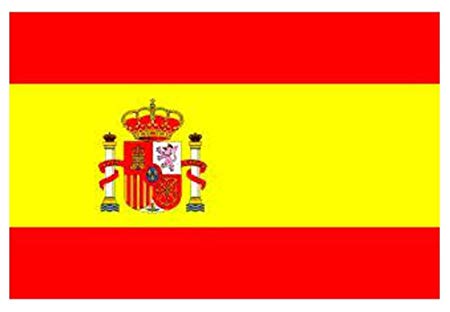 |
The result of the census of 20 December 2019 in Spain was 222,926 cranes. By region these were 125,558 in Extremadura, 40,070 in Aragón, 34,976 in Castilla la Mancha, 13,107 in Andalucia, 6,465 in Castilla y León, 2,683 in Navarra and 65 in other 'Autonomous Communities'. Source: Cranes in Europe Facebook. |
Breeding cranes in the UK, 2017: in the report Rare breeding birds in the UK in 2017 (British Birds, December 2019) the population is noted as 31 breeding pairs at 19 sites (29-37 pairs). There are some paired but non-breeding birds associated with various sites, which accounts for the range given.
The BB report gives numbers by counties: simplifying this to local populations by area, the 31 pairs were located as follows:
The Broads: 10 pairs
The Fens: 7
pairs
SW England and S Wales (the reintroduced population): 9 pairs
Elsewhere (Oxfordshire,
Yorkshire and Scotland): 5 pairs.
France: 268,120 cranes were counted at Lake Der-Chantecoq, north-east France, on 3 November 2019, breaking the European record for a single-site count of the species. Full story on BirdGuides here.
Cranes nest at Wicken Fen, Cambridgeshire: news from the National Trust here, May 2019. See also Scotland, 2019, right.
The Norfolk Cranes' Story in paperback: we are pleased to announce a reprint, with minor additions, of The Norfolk Cranes' Story. This is available through various outlets: see buy the book.
Martin Woodcock 1935-2019: the artist of the cover of The Norfolk Cranes' Story died in February 2019. There are tributes online in the Eastern Daily Press, The Guardian and by author Mark Cocker. Martin's best known work was the multivolume The Birds of Africa but there was much more, noted in the tributes. These were planned contributions from a great talent: by contrast, providing the cover for The Norfolk Cranes' Story was an accident. The cover painting of cranes over Brograve Mill was designed as a book wrap-around with spaces for words and was originally commissioned by Moss Taylor for The Norfolk Bird Atlas. The BTO went for a photo-based design instead, so it was easy and ideal to use it for our book instead. Martin was pleased with the outcome.
Ringed blue crane in Namibia
At Koinachas waterhole near Namutoni on 15 November 2018. the Honeyguide Wildlife Holidays group with Chris Durdin saw two blue cranes.
This one had a turquoise colour-ring with the letters NBZ. Via email we made contact with Ann and Mike Scott in Namibia. They write: "This bird was ringed in April 2008 east of the causeway near Namutoni. As you mention, we have had frequent sightings, usually in the area near Chudop where it has tried to breed for several years. "The pair raised two chicks successfully in the 2016-2017 breeding season although not in 2017-2018. NBZ was also spotted at Koinachas on 21 and 23 November 2018." |
|
Visit to Gallocanta: thanks to the kind invitation of the Spanish Tourist Board, I visited Lake Gallocanta in November 2017, writes Chris. We stayed at the Hotel Allucant, where there were crane pictures everywhere, an exhibition of wildlife photos and an impressive library of wildlife books - plainly the place to stay at Gallocanta for crane enthusiasts.
Javier and Litzan were our hosts and they showed us data sheets of recent years’ crane counts collected for and published (here) by the Aragón Government. There are regularly 20,000 cranes at Gallocanta in November and February, on the cranes’ way to and from Extremadura; sometimes 50,000+. But the pattern can be less straightforward than this: there are high numbers in mid-winter on some occasions, too. However this year’s drought meant most cranes had already moved on with recent counts of around 2,000 or 2,500. We saw about 300 cranes at daybreak on 23 November. Report here and an addition to Hotel Allucant's library here.
Gallocanta Lake? No, a salt bed where the lake should be, in November 2017. There is a hide and huge crane model overlooking the salt pan's edge. For count data from the main crane sites in Europe see www.grus-grus.eu. This link takes you to the English version of the website for the Champagne-Ardenne LPO group.
Autumn cranes in Poland: it's a wet autumn in Poland - "terrible weather" says Artur Wiatr, local guide for Honeyguide Wildlife Holidays. Cranes are gathering in flocks before they move off for the winter: some local birds, some migrants in the 5,000 birds seen around Biebrza Marshes and in the neighbouring Narew River Valley. Artur sent six photos by Piotr Talalaj: one is below and all are on Honeyguide's Facebook. The cranes will be back on the nesting grounds for next May's Poland holiday, for which places are available.

Cranes in Poland, October 2017 (Piotr Talalaj). More photos on Facebook.
Cranes at Lakenheath Fen 2017: the pair dubbed 'Little and Large' disappeared in April but the second pair of cranes at this RSPB nature reserve in Suffolk fledged one chick in July. This means this pair has fledged five young on the reserve and it was the the 12th chick fledged in total here since 2007. Source: RSPB. In Somerset, the Great Crane Project reports "an odd year for the cranes" with several pairs not nesting on account of the dry spring, but three pairs at RSPB West Sedgemoor nature reserve successfully fledged four young. More here.
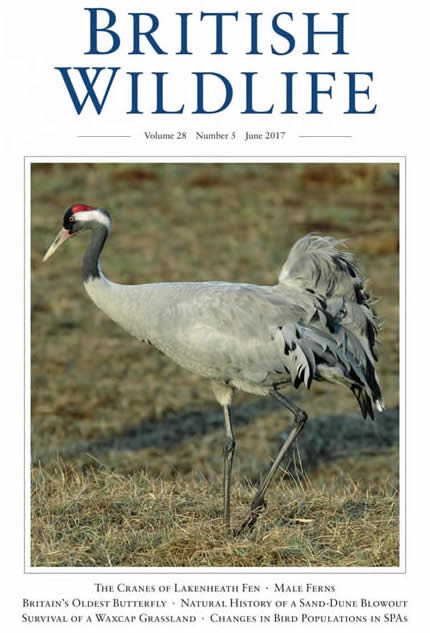 |
'The Cranes of Lakenheath Fen' is the title of a paper by Norman Sills in British Wildlife, June 2017 (left). The story starts with the cranes' arrival at this newly created RSPB nature reserve in 2007. That was during a UK-wide influx, with two pairs on territory here then and every year since. Choice of nest area, incubation and foraging areas are described. A section on management stresses the risk of disturbance for this sensitive species and the value of predator control. |
Where to buy The Norfolk Cranes' Story: the book is presently on sale via Chris, online via NHBS and WildSounds, in Jarrolds (Norwich) and Norfolk Wildlife Trust shops. See buy the book for more information.
Record number of cranes in the UK: 2016 is the best year ever for cranes (well, at least for several centuries) with 48 pairs and 160 birds, and 14 chicks were fledged. News story in full on Birdguides here. "The population is now roughly half from the Great Crane Project's reintroductions and half from the natural re-colonisation that has been occurring in the east of England for the last 30 years." November 2016. 'Rare breeding birds in the UK in 2016' in British Birds, November 2018, gives a lower total of 32-38 breeding pairs with 18 fledged. The differences between the figures are because some other pairs are classed as non-breeding pairs here, and the higher number fledged will be improved data gathered by the UK Crane Working Group.
Hickling nature reserve appeal: Norfolk Wildlife Trust today (2 November 2016) launched a £1 million appeal to buy the freehold of Hickling nature reserve. Hickling is, of course, a regular site for cranes - they've bred there since 2003 - plus so much more. More here.
Heading south: The annual autumn sight of flocks of cranes moving through the Dordogne, France, started on 5 October, reports Keith Parker from the Honeyguide Wildlife Holidays base at Castang ... and it was all over by 7 October. They hadn't reached Extremadura in time for the Honeyguide group there in early October, but I don't think we can blame French air traffic control this time ...

Common crane fledges in Wales after a four-century absence
The good news is that cranes nested on the Gwent Levels, and come from the reintroduced birds of the Great Crane Project based in Somerset. More here. The bad news is that the project's "best breeding female" has been found shot dead on the Somerset Levels. Details here. October 2016.
Breeding success at RSPB Lakenheath Fen
For the second year running, two pairs of cranes have successfully raised three crane chicks between at the RSPB's Lakenheath Fen nature reserve on the Suffolk/Norfolk border. The RSPB is highlighting that this occurred close to the railway line that runs alongside the reserve. More here.
August 2016
The Norfolk cranes' story on BBC Countryfile
The BBC Countryfile team was in the Broads on 28 and 29 January, and the programme they filmed featured the Norfolk Cranes' Story as well as other stories from Hickling and Berney Marshes. It was broadcast on 14 February 2016 and repeated on BBC2 on 21/22 February. It's on YouTube here. Photos from the day of filming here on Facebook. Read the story behind the filming in this PDF here.
Blue crane in South Africa's Southwest Cape, enjoyed by Chris Durdin and a group in October 2015. More photos from SA on Facebook here.
Photo by Geoff Crane |
Cranes fledge in Somerset ...
Young cranes have taken the wing in western England for the first time in four centuries. One young was raised at WWT Slimbridge in Gloucestershire and two on the Somerset Levels. These are birds from the successful 'Great Crane Project' reintroduction scheme. Source: WWT (more here), August 2015.
... and the Broads, 2015
In the Broads, nine pairs fledged four young in 2015, with 1-3 other pairs possibly breedings.
Three cranes fledge at RSPB Lakenheath Fen
The RSPB nature reserve on the Suffolk-Norfolk border is celebrating its best year for cranes. Three young reached the flying stage during July 2015, when they become fairly safe from being lost to predators. One pair fledged two young and a second pair one. The success is all the more remarkable as it's a wetland created from former arable land, now in its 20th year. Source: RSPB (more here), July 2015.
139,000 cranes in Extremadura
The results of the January 2015 Extremadura crane census are now compiled: a new record with a total of 139,101 birds counted.
Source: Martin Kelsey in Extremadura.

This picture is of cranes flying to roost in Gallocanta, Aragón in Spain, and was taken on 24 January 2014 by Pau Lucio, Honeyguide Wildlife Holidays leader in La Mancha. Pau says: "The number of cranes was between 17,000 and 18,000. Apparently there are more cranes than in previous weeks as a result of cold weather in France. Nevertheless, that is nothing compared with the 48,663 cranes than wintered last year in Gallocanta (a record); a hailstorm damaged many of the crops so there was a lot of food for them."
This comes shortly before a Honeyguide group goes to crane country in Extremadura, where last winter (2013/14) there was also a record count of 140,000 cranes (see story below). This is all linked to the steady growth in crane numbers and their westward spread as a breeding bird, recolonising parts of their former range, including the UK.
Breeding season 2014
It was a good season for cranes in the Broads: final figures were 9 pairs raised 8 young, plus two probable and one possible breeding pairs, plus a further two non-breeding pairs.
The overall total for the UK was 21-26 pairs with 11 young fledged. Four of these pairs were from the Great Crane Project reintroduction scheme in SW England. Source: Rare breeding birds in the United Kingdom in 2014 in British Birds, September 2016.
Horsey cranes 2011 — 2013
The Norfolk Cranes’ Story book tells the Horsey cranes’ story until 2010. Click here to read what happened at Horsey from 2011 to 2013. This includes a story from the early days that has come to light since the book was published.
Record count of cranes in France
Co-ordinated counts at le lac du Der-Chantecoq recorded 84,100 cranes on 27 October 2013. That's a record for the area, a regular stop-off for migrants on their way towards SW France and Spain. Normally between 10,000 and 20,000 winter in this area, too. Last winter there were more than 40,000 — another record. A mild winter, unfrozen soil and lack of snow meant fewer needed to go farther south — making the record count of cranes in Extremadura (news item below) all the more remarkable.
Source: LPO's L'OISEAU magazine no 114, spring 2014.
130,000 cranes in Extremadura
In March 2014, the group from Honeyguide Wildlife Holidays met Marcelino Cardalliaguet from SEO/BirdLife in Extremadura. Marcelino told us that last winter's co-ordinated count of cranes in Extremadura found a record number — 140,000* birds in the winter of 2013/14, roughly three-quarters of the cranes in western Europe. His view was that the increase was partly real, partly from an improved census. * The 'official' figure released later was 128,821.
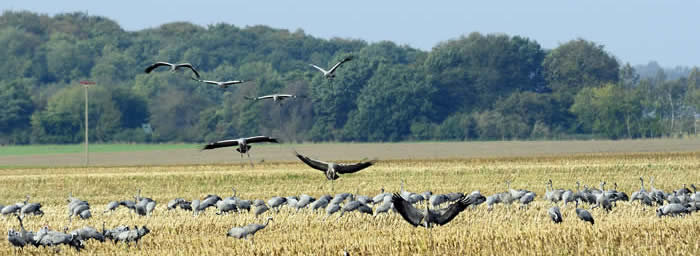
it's all a reminder that crane numbers are growing and their range is moving westwards, leading to the re-colonisation of many parts of their former range, including the UK. (Photo: Nick Upton)
February 2014: more than 100 cranes in the UK
Counts coordinated by the UK Crane Working Group in February 2014 found 31 cranes in the Broads and 21 in the Fens. In addition to these in East Anglia, there were four elsewhere in the UK. Add in 64 birds in the Somerset area - one a wild bird with 63 released by the Great Crane Project - and that's a minimum of 120 cranes in the UK, plus two in Ireland. The East Anglia count is slightly up on 51 in November 2013.
John Buxton 1927-2014.
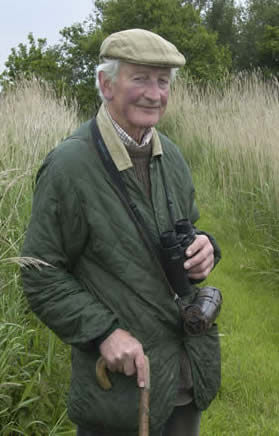 |
John died peacefully at Horsey on 11 January 2014, surrounded by all his family, aged 86. "Adored husband of Bridget and much-loved by all his children and grandchildren." Eastern Daily Press obituary here. Some 500 people celebrated John's life at Winterton-on-Sea church on 24 January. Obituary by Chris Durdin here, published in British Birds, May 2014. John Buxton (Natural England) |
Cranes nest successfully in Scotland
One young crane was raised at an undisclosed site in Scotland in both 2012 and 2013, says the RSPB — the first time since the Middle Ages. More here. September 2013
Cranes nest near Slimbridge
Two of the re-introduced birds in the Somerset Levels & Moors have made a nest. Will eggs be laid, or are they too young? More on the Great Crane Project website or on bbc.co.uk. April 2013
100 + cranes in the UK
A co-ordinated count of cranes on 18 November 2012 found a minimum of 63 birds in the Broads and Fens, plus 52 released birds in Somerset/Gloucestershire.
Results from the national count on 12 February 2013 were a minimum of 53 birds, mainly in eastern England, though five were in the republic of Ireland. (Source: UK Crane Working Group.) Breeding numbers in 2012 — see right.
Record crane count in Extremadura
Co-ordinated roost counts in Extremadura in late December 2012 recorded 110,000 cranes. The region is a key wintering area for cranes, in the Spanish dehesa (wood pasture) and rice fields, and this count shows that numbers continue to rise.
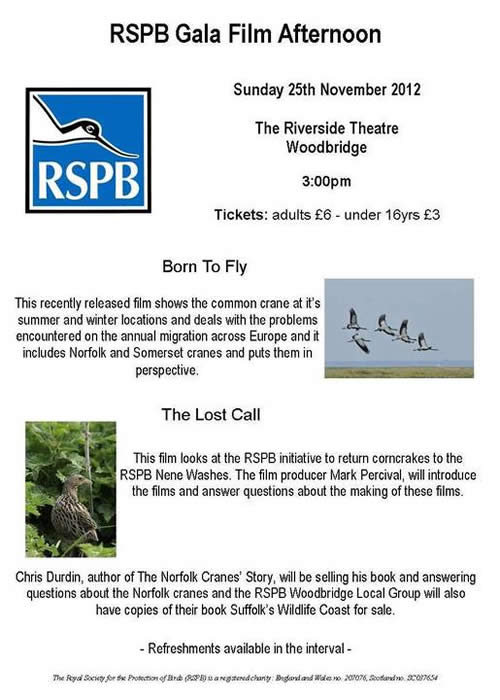 |
Crane film in Woodbridge, 25 November. Born to Fly (see below, or Cranes on film), is part of an 'RSPB Gala Film Evening run by the RSPB Woodbridge Local Group on Sunday 25 November. Venue: The Riverside Theatre, Woodbridge. Doors open 3pm. Cost: adults £6, under 16 years £3. Chris Durdin from The Norfolk Cranes' Story will be there, with books for sale. |
Return of the cranes to Somerset
There's a 30 minute film — view it here — on the reintroduction project in Somerset. The film is produced by Nick Upton, who wrote part three of The Norfolk Cranes' Story. The natural recolonisation of the Broads some three decades earlier features for about a minute in the film, including some of John Buxton's film archive of the early days. September 2012
Habitats for Common Cranes - British Wildlife paper
The August 2012 British Wildlife leads on this paper by RSPB researcher Andrew Stanbury and Norman Sills, site manager at RSPB Lakenheath Fen nature reserve until his retirement in 2011 (though he's as busy as ever). Read or download the paper here.
The Changing Status of Common Cranes in the UK was published in the August 2011 edition of British Birds. More information at the bottom of the right hand column.
Born to Fly - RSPB crane film by Nick Upton
If you've enjoyed the book you'll love the film. Part three of the book is Cranes in Europe, where Nick Upton tells the story of cranes from Scandinavia to Spain, weaved into his film-making. 'Born to Fly' is the result, and it's very good. More information, including how to order, on the RSPB's website.
Posted 19 December 2011


Cranes in Extremadura by Steve Fletcher. Find out here how the Honeyguide group fared for cranes in Extremadura in February 2012.
2011 update - a record year
There were about 16 pairs of cranes in England in 2011, according to figures collated by the UK Crane Working Group in November 2011, though information gathering is still under way. This is the highest number since their first nesting attempt at Horsey in 1981 after a gap of some 400 years.
Half of these nesting pairs were in the Broads, with the others in the Fens, Yorkshire and elsewhere. Five or six young were fledged. Several other birds spent the summer but were not known to have attempted to nest.
At Horsey, there were three pairs. The easiest pair to observe at Horsey had a "lazy" male, according to John Buxton, though reached the chick stage. There were probably two pairs out of sight in the fen, and a fledged, juvenile crane that appeared on the adjacent marshes at the National Trust's Heigham Holmes is though to have come from here.
Total numbers of cranes in the British Isles are much higher than the figure for nesting pairs might at first suggest. There are non-breeding birds, number uncertain but in low double figures; 34 birds in Somerset released as part of The Great Crane Project; and there's been an influx of migrant cranes this autumn, notably into Cornwall/Devon and the Republic of Ireland.
East Anglian Book Awards
The Norfolk Cranes' Story was shortlisted, though not a winner, for this year's Eastern Daily Press / Jarrold East Anglian Book Awards. The winner in the category 'Places and Nature: for books about the nature or landscape of East Anglia', announced at an event on 3 November 2011, was This Luminous Coast by Jules Pretty. But it was fun to be involved and nominated, and all part of the learning curve about the world of books. More here.
Let's Talk magazine, The book features in 'Roy's Reads' (extract, right). ______________ See praise by Richard Mabey in BBC Wildlife magazine on our reviews page. |
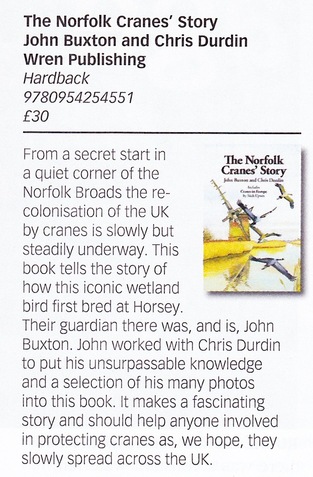 |
Top of Jarrold chart
The Norfolk Cranes' Story was top in the Jarrold's list of local best sellers list in the Eastern Daily Press 24 September 2011 (having been no. 5 the previous week). That was a one-off, helped by a Jarrold customer evening at which John was signing books, but a nice moment.
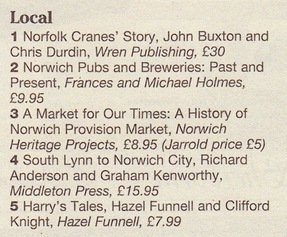
John and Chris would like to say thank you to Jarrolds for their support and encouragement of the book. It remains an excellent place to buy it: signed copies are in stock. April 2013
Norfolk media launch
The Eastern Daily Press's Weekend paper carried a double page spread about the book on 13 August 2011, by EDP Agricultural Editor Michael Pollitt. BBC Radio Norfolk - see right. The big EDP piece is too big to show here, but here's an extract with 'strange observations': two from the book, one not.
